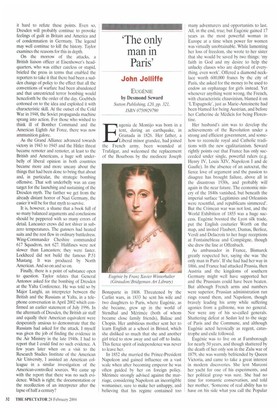Laying a persistent ghost
Noble Frankland
DRESDEN by Frederick Taylor Bloomsbury; £20, pp. 518, ISBN 0747570787 Although it probably won't, this book deserves to lay the ghost of Dresden, to demolish the myth and establish the rule of objective historical judgment. Frederick Taylor opens his investigation as long ago as AD 350 and carries it down to 2003. On the way, he gives us a condensed history of the strategic air offensive, explaining especially the evolution of area bombing, and of the development of the German air defences. He considers the policies and reactions of the British and American authorities, Churchill. Stimpson, the chiefs of staff and the C-in-C Bomber Command, Sir Arthur Harris, among them, and of the German authorities, including Hitler, Goebbels and Mutschmann, the Dresden Gauleiter, and of the Russians, notably General Antonov, their leading airman at Yalta. He has interviewed German survivors of the firestorm and British and American aircrews who took part in the attacks. In short, he has scarcely left a stone unturned.
What then are Taylor's principal conclusions?
First, the decision to attack Dresden was not extraordinary. It was based partly on Churchill's instruction that something spectacular should be done to assist the advance of the Red Army and partly on the steady development of the policy of devastating major German cities by area bombing that had been inaugurated at Mannheim in 1940.
Secondly, Dresden was not just a city of cultivated art. It was also a notable stronghold of Nazism, peppered with light war industry and a key point in the German railway system. In October 1944, for example, Dresden's rail system was handling the passage of 20,000 troops per day.
Thirdly, the number killed in the raids was not 135,000 (David Irving), nor was it 320,000 (East German propaganda); it was probably about 40,000 (Goebbels's private estimate).
Fourthly, the attack was not unnecessarily and maliciously carried out after the war was effectively over. At the time of the attack, the German Army Group Centre, operating to the east of Dresden, had a million men under command fighting to halt the advance of the Red Army.
Those who have seen the sources will find it hard to refute these points. Even so, Dresden will probably continue to provoke feelings of guilt in Britain and America and of condemnation in Germany. The legend may well continue to kill the history. Taylor examines the reasons for this in depth.
On the morrow of the attacks, a British liaison officer at Eisenhower's headquarters, who was either careless or stupid, briefed the press in terms that enabled the reporters to take it that there had been a sudden change of policy to the effect that all the conventions of warfare had been abandoned and that unrestricted terror bombing would henceforth be the order of the day. Goebbels cottoned on to the idea and exploited it with characteristic skill. At the outset of the Cold War in 1948, the Soviet propaganda machine sprang into action. For those who wished to think ill of Bomber Command and the American Eighth Air Force, there was now ammunition galore.
As the Grand Alliance advanced towards victory in 1943 to 1945 and the Hitler threat became remoter and remoter, at least to the British and Americans, a huge soft underbelly of liberal opinion in both countries became more and more uneasy about the things that had been done to bring that about and, in particular, the strategic bombing offensive. That soft underbelly was an easy target for the launching and sustaining of the Dresden myth. The farther we get from the already distant horror of Nazi Germany, the easier it will be for that myth to survive.
It is, however, a shame that a book full of so many balanced arguments and conclusions should be peppered with so many errors of detail. Lancaster crews did not shiver in subzero temperatures. The gunners had heated suits and the rest flew in ordinary battledress. Wing-Commander Cheshire commanded 617 Squadron, not 627. Halifaxes were not slower than Lancasters; they were faster. Lockheed did not build the famous P.51 Mustang. It was produced by North American. And so on and so on.
Finally, there is a point of substance open to question. Taylor relates that General Antonov asked for the bombing of Dresden at the Yalta Conference. He was told so by Major Lunghi, an interpreter between the British and the Russians at Yalta, in a telephone conversation in April 2002 which confirmed an earlier statement of July 1996. In the aftermath of Dresden, the British air staff and equally their American equivalent were desperately anxious to demonstrate that the Russians had asked for the attack. I myself was given the job of finding the evidence in the Air Ministry in the late 1940s. I had to report that I could find no such evidence. A few years later when on a visit to the Research Studies Institute of the American Air University, I assisted an American colleague in a similar investigation of the American-controlled sources. We came up with the report that there was no such evidence. Which is right; the documentation or the recollection of an interpreter after the lapse of half a century?



























































 Previous page
Previous page